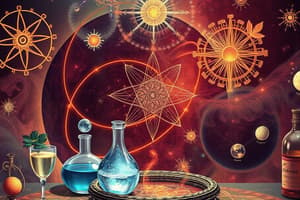Podcast
Questions and Answers
What did Democritus believe all matter was made of?
What did Democritus believe all matter was made of?
Atoms
Democritus proved his theories about atoms with experiments.
Democritus proved his theories about atoms with experiments.
False (B)
Dalton believed that atoms could be divided into smaller substances.
Dalton believed that atoms could be divided into smaller substances.
False (B)
Dalton's model of the atom is considered the most accurate representation of the atom.
Dalton's model of the atom is considered the most accurate representation of the atom.
What did J.J. Thomson discover that contradicted Dalton's theory?
What did J.J. Thomson discover that contradicted Dalton's theory?
Thomson's atomic model is often referred to as the ______ model.
Thomson's atomic model is often referred to as the ______ model.
What did Rutherford's experiment with gold foil reveal about the atom?
What did Rutherford's experiment with gold foil reveal about the atom?
According to Bohr's model, electrons travel in a random, unpredictable path around the nucleus.
According to Bohr's model, electrons travel in a random, unpredictable path around the nucleus.
What replaced Bohr's model of fixed electron orbits?
What replaced Bohr's model of fixed electron orbits?
Which of the following is NOT a subatomic particle?
Which of the following is NOT a subatomic particle?
The atomic number of an element is determined by the number of neutrons in the nucleus.
The atomic number of an element is determined by the number of neutrons in the nucleus.
What is the simplest atom called, which consists of one proton and one electron?
What is the simplest atom called, which consists of one proton and one electron?
Isotopes of an element have the same number of protons but different numbers of electrons.
Isotopes of an element have the same number of protons but different numbers of electrons.
What is the term for unstable isotopes that decay over time, emitting particles and energy?
What is the term for unstable isotopes that decay over time, emitting particles and energy?
The weak force is primarily responsible for the stability of atoms.
The weak force is primarily responsible for the stability of atoms.
The ______ model is considered the most current and accurate representation of the atom.
The ______ model is considered the most current and accurate representation of the atom.
Flashcards
Atom
Atom
The smallest particle of an element that can exist and still retain the chemical properties of that element.
Democritus
Democritus
Ancient Greek philosopher who first proposed the idea of atoms as indivisible particles.
Solid Sphere Model
Solid Sphere Model
Dalton's model of the atom, where atoms are viewed as solid, indivisible spheres.
Isotopes
Isotopes
Atoms of the same element that have the same number of protons but different numbers of neutrons.
Signup and view all the flashcards
Electromagnetic Force
Electromagnetic Force
The force that attracts the negatively charged electrons to the positively charged nucleus.
Signup and view all the flashcards
Plum Pudding Model
Plum Pudding Model
The model of the atom proposed by J.J. Thomson, where electrons are embedded in a positively charged sphere like plums in a pudding.
Signup and view all the flashcards
Nucleus
Nucleus
The central part of an atom, containing protons and neutrons.
Signup and view all the flashcards
Proton
Proton
A positively charged particle found in the nucleus of an atom.
Signup and view all the flashcards
Electron
Electron
A negatively charged particle that orbits the nucleus of an atom.
Signup and view all the flashcards
Neutron
Neutron
A neutral particle found in the nucleus of an atom.
Signup and view all the flashcards
Atomic Number
Atomic Number
The number of protons in the nucleus of an atom, which determines the element's identity.
Signup and view all the flashcards
Mass Number
Mass Number
The total number of protons and neutrons in the nucleus of an atom.
Signup and view all the flashcards
Stable vs Unstable Isotopes
Stable vs Unstable Isotopes
A stable isotope is one that does not decay over time, while an unstable isotope will decay, emitting particles and energy.
Signup and view all the flashcards
Strong Force
Strong Force
The force that holds the protons and neutrons together in the nucleus, despite the repulsive forces between the protons.
Signup and view all the flashcards
Weak Force
Weak Force
The force responsible for the decay of unstable isotopes, allowing neutrons to transform into protons and electrons.
Signup and view all the flashcards
Ernest Rutherford
Ernest Rutherford
Scientist who discovered that atoms contain a positively charged nucleus, with electrons orbiting around it.
Signup and view all the flashcards
Niels Bohr
Niels Bohr
Scientist who proposed that electrons move around the nucleus in specific energy levels or shells.
Signup and view all the flashcards
Bohr Model
Bohr Model
The model of the atom proposed by Niels Bohr, where electrons orbit the nucleus in specific energy levels.
Signup and view all the flashcards
Electron Cloud
Electron Cloud
The region around the nucleus of an atom where electrons are most likely to be found.
Signup and view all the flashcards
Quantum Model
Quantum Model
The modern model of the atom, which incorporates the idea of electron clouds and the uncertainty of electron positions.
Signup and view all the flashcards
Ionization
Ionization
The process by which an atom gains or loses electrons, resulting in a charged atom called an ion.
Signup and view all the flashcards
Ion
Ion
A charged atom formed by the gain or loss of electrons.
Signup and view all the flashcards
Cation
Cation
An ion that has a positive charge, formed when an atom loses electrons.
Signup and view all the flashcards
Anion
Anion
An ion that has a negative charge, formed when an atom gains electrons.
Signup and view all the flashcards
Chemical Bonding
Chemical Bonding
The process by which atoms combine to form new substances with different properties.
Signup and view all the flashcards
Covalent Bonding
Covalent Bonding
A type of chemical bond formed by the sharing of electrons between atoms.
Signup and view all the flashcards
Ionic Bonding
Ionic Bonding
A type of chemical bond formed by the transfer of electrons from one atom to another.
Signup and view all the flashcards
Molecule
Molecule
The smallest unit of a compound that retains the chemical properties of that compound.
Signup and view all the flashcardsStudy Notes
Atomic Theory Timeline
- Democritus (440 BCE) proposed that matter is composed of indivisible particles called atoms.
- John Dalton (1803) developed a theory that:
- All matter is composed of atoms
- Atoms of the same element are identical and different from atoms of other elements
- Atoms combine in whole number ratios to form compounds
- Atoms rearrange in chemical reactions
- J.J. Thomson (1897) discovered electrons, proposing a "plum pudding" model where electrons are embedded in a positively charged sphere.
- Ernest Rutherford (1909) performed the gold foil experiment, showing that atoms have a small, dense, positively charged nucleus with electrons orbiting around it. Most of an atom is empty space.
- Niels Bohr (1913) refined the model by proposing that electrons orbit the nucleus in specific energy levels.
- Erwin Schrödinger & Werner Heisenberg (1926): Developed the modern model—modern atomic theory. Electrons do not have fixed paths but exist in regions of probability called electron clouds.
Atomic Structure
- Atoms consist of a nucleus containing protons (positive charge) and neutrons (no charge).
- Electrons (negative charge) orbit the nucleus.
- Atomic number = number of protons.
- Mass number = number of protons + neutrons.
Isotopes
- Isotopes are atoms of the same element with different numbers of neutrons, thus different mass numbers.
- Some isotopes are stable, while others are radioactive.
- Radioactive isotopes decay over time releasing particles and energy.
Forces Within Atoms
- Gravitational force: very small force.
- Electromagnetic force: strong attraction between protons and electrons. Keeps electrons in motion around the nucleus.
- Strong force: binds protons & neutrons together in the nucleus, overcoming the electromagnetic repulsion that would cause protons to repel each other.
- Weak force: involved in radioactive decay, allows neutrons to change into protons & electrons.
Studying That Suits You
Use AI to generate personalized quizzes and flashcards to suit your learning preferences.




